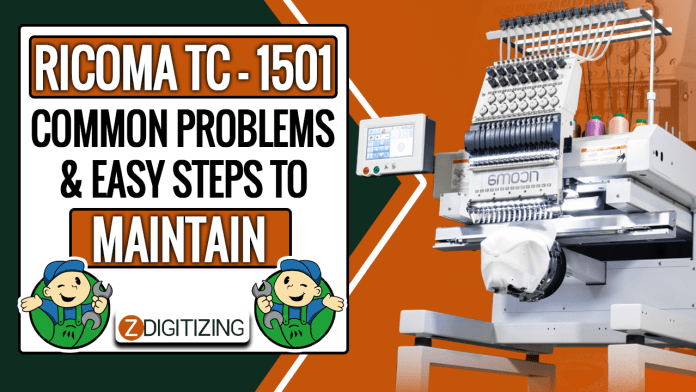The Ricoma TC-1501 embroidery machine is a remarkable tool for those passionate about creating stunning embroidery designs. Whether you’re part of an embroidery digitizing company, crafting machine embroidery designs, or just starting out in the world of embroidery, the TC-1501 offers a wide range of creative possibilities. However, like any sophisticated piece of machinery, it may encounter issues from time to time. In this comprehensive guide, we will explore common problems associated with the Ricoma TC-1501 embroidery machine and provide practical solutions to troubleshoot and fix them. Additionally, we will discuss easy steps for maintaining your machine to ensure its longevity and optimal performance.
Understanding the Ricoma TC-1501 Embroidery Machine
Before we delve into troubleshooting and maintenance, let’s become familiar with the key features and components of the Ricoma TC-1501 embroidery machine:
1. Large Embroidery Area:
- The TC-1501 boasts an expansive 15.7″ x 11.8″ embroidery field, allowing you to create intricate and large-scale designs.
2. Touchscreen Interface:
- The user-friendly touchscreen interface simplifies design selection, customization, and machine control.
3. High-Speed Operation:
- With a top speed of 1,200 stitches per minute, this machine is capable of handling complex and high-volume embroidery projects.
4. Automatic Thread Trimmers:
- The machine is equipped with automatic thread trimmers, enhancing efficiency and precision during embroidery.
Now that we are acquainted with the machine, let’s explore common issues you might encounter with the Ricoma TC-1501 and how to resolve them.
Troubleshooting Common Ricoma TC-1501 Issues
While the Ricoma TC-1501 is designed for reliability, it’s essential to be prepared for potential problems. Here are some common issues and their solutions:
1. Thread Breakage or Tension Problems
Possible Causes:
- Incorrect thread tension settings.
- Dirty or damaged tension disks.
- Dull or bent needles.
Troubleshooting Steps:
- Check Thread Tension: Ensure that the thread tension is correctly set for your chosen fabric and thread type. Refer to your machine’s manual for guidance.
- Clean or Replace Tension Disks: If the tension disks are dirty or damaged, clean them carefully or replace them as necessary.
- Replace Needles: Dull or bent needles can cause thread breakage. Replace the needles regularly to maintain clean stitches.
2. Thread Jam or Bird’s Nest Under the Fabric
Possible Causes:
- Incorrect bobbin threading.
- Improper hooping or fabric placement.
- Incorrect upper thread threading.
Troubleshooting Steps:
- Rethread the Bobbin: Ensure the bobbin is correctly threaded, and the thread is securely in place.
- Check Fabric Hooping: Ensure the fabric is hooped evenly and securely, without wrinkles or folds.
- Verify Upper Thread: Double-check the upper thread path to ensure it’s correctly threaded through all guides and the needles.
3. Design Misalignment
Possible Causes:
- Improper hooping or stabilizing.
- Incorrect design placement.
- Design resizing or distortion.
Troubleshooting Steps:
- Proper Hooping and Stabilizing: Ensure that the fabric is hooped evenly and that you are using the appropriate stabilizer for your fabric.
- Design Placement: Use the machine’s touchscreen interface to accurately position and center the design within the hoop.
- Avoid Design Distortion: When resizing or adjusting designs, maintain the original aspect ratio to prevent distortion.
4. Machine Error Messages
Possible Causes:
- Software glitches.
- Mechanical issues.
- Electrical problems.
Troubleshooting Steps:
- Restart the Machine: Sometimes, a simple restart can resolve software glitches. Turn off the machine, wait a few seconds, and turn it back on.
- Check for Mechanical Issues: Inspect the machine for any visible obstructions, loose parts, or damaged components. Consult the machine’s manual for guidance.
- Contact Technical Support: If the issue persists, contact the manufacturer’s technical support for professional assistance.
Preventive Maintenance for the Ricoma TC-1501
To ensure the longevity and optimal performance of your Ricoma TC-1501 embroidery machine, regular preventive maintenance is essential. Here are some maintenance tips to follow:
1. Cleaning
- Regular Cleaning: After each embroidery session, clean the machine thoroughly, including the bobbin area, thread paths, and needles. Remove any lint or debris that may accumulate.
- Oil Properly: Follow the machine’s manual to lubricate the recommended points with sewing machine oil. Avoid over-oiling, as it can attract more lint.
2. Needle Maintenance
- Replace Needles: Change the needles regularly, especially if they become dull or bent. Fresh needles ensure clean stitches and prevent thread breakage.
3. Bobbin Care
- Clean the Bobbin Area: Periodically, remove the bobbin case and clean out any lint or debris that may accumulate.
4. Thread Quality
- Use Quality Thread: Invest in high-quality embroidery thread. Low-quality threads can cause issues such as fraying, breaking, or tension problems.
5. Software Updates
- Check for Updates: If your machine is computer-connectable, periodically check for software updates and firmware upgrades to ensure it operates smoothly with the latest features and bug fixes.
Leveraging Embroidery Digitizing Services
For intricate or custom embroidery designs, consider working with embroidery digitizing company. These professionals can convert your ideas and artwork into digitized embroidery files compatible with your machine. Whether you’re looking to create intricate lace designs or reproduce detailed artwork, their expertise ensures high-quality results.
In Conclusion
The Ricoma TC-1501 embroidery machine is a valuable tool for embroidery enthusiasts and professionals alike. By addressing common issues, following preventive maintenance practices, and seeking professional support when needed, you can enjoy seamless embroidery experiences and maximize the performance and longevity of your machine. Whether you’re creating intricate designs, contributing to an embroidery digitizing company, or exploring the world of embroidery, your Ricoma TC-1501 can be a reliable partner in bringing your creative visions to life.
